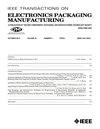Low-Stress Thermosonic Copper Ball Bonding
IEEE Transactions on Electronics Packaging Manufacturing
Pub Date : 2009-06-02
DOI:10.1109/TEPM.2009.2019123
引用次数: 43
Abstract
Thermosonic ball bonding processes on test chips with Al metallized bonding pads are optimized with one Au and two Cu wire types, all 25 mum diameter, obtaining average shear strengths of more than 120 MPa. The process temperature is ~110degC. Ball bonds made with Cu wire show at least 15% higher shear strength than those made with Au wire. The estimated maximum shear strength cpk value determined for Cu ball bonding (cpk = 3.7 plusmn 1.2) is almost 1.5 times as large as that of the Au ball bonding process (cpk = 2.3 plusmn 0.9), where LSL is 65.2 MPa. However, the ultrasound level required for Cu is approximately 1.3 times than that required for Au. Consequently, about 30% higher ultrasonic forces induced to the bonding pad are measured using integrated real-time microsensors. The accompanying higher stresses increase the risk of under-pad damage. One way to reduce ultrasonic bonding stresses is by choosing the softer of the two Cu wire types, resulting in a measured ultrasonic force reduction of about 5%. A second way is to reduce the ultrasound level. While this causes the average shear strength to fall by 15%, the ultrasonic force falls by 9%. The cpk value does not change significantly, suggesting that a successful Cu ball bonding operation can be run with about 0.9 times the conventionally optimized ultrasound level. The process adjusted in this way reduces the extra stress observed with Cu wire compared to that observed with Au wire by 42%.低应力热超声铜球键合
采用1种Au线和2种Cu线,直径均为25 μ m,优化了Al金属化焊盘在测试芯片上的热超声球键合工艺,平均剪切强度大于120 MPa。工艺温度为~110℃。用铜丝制成的球键比用金丝制成的球键的抗剪强度至少高15%。估计Cu球键合的最大剪切强度cpk值(cpk = 3.7 plusmn 1.2)几乎是Au球键合的最大剪切强度cpk值(cpk = 2.3 plusmn 0.9)的1.5倍,其中LSL为65.2 MPa。然而,Cu所需的超声水平大约是Au所需的1.3倍。因此,使用集成的实时微传感器可以测量到约30%的高超声力。伴随的高应力增加了衬垫下损伤的风险。减少超声波粘合应力的一种方法是选择两种铜丝类型中较软的一种,从而使测量到的超声波力降低约5%。第二种方法是降低超声波水平。虽然这导致平均抗剪强度下降15%,但超声波力下降9%。cpk值没有显著变化,这表明成功的Cu球键合操作可以在约0.9倍的常规优化超声水平下进行。以这种方式调整的工艺与用金线观察到的相比,减少了用铜线观察到的额外应力42%。
本文章由计算机程序翻译,如有差异,请以英文原文为准。
求助全文
约1分钟内获得全文
求助全文

 求助内容:
求助内容: 应助结果提醒方式:
应助结果提醒方式:


